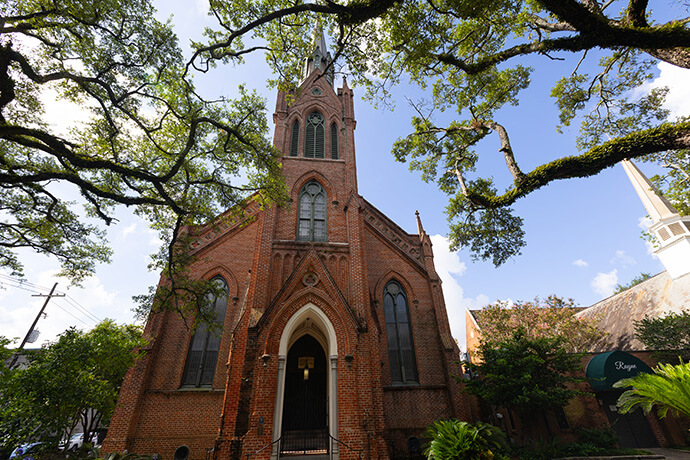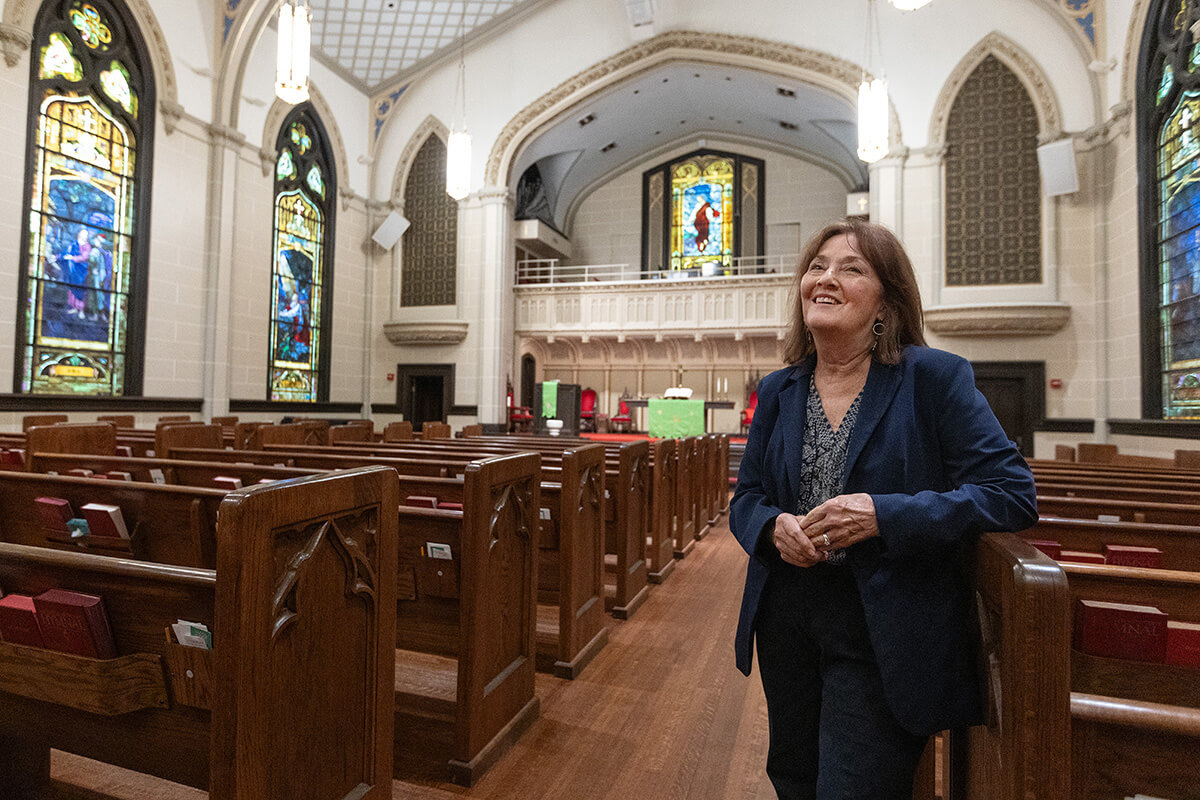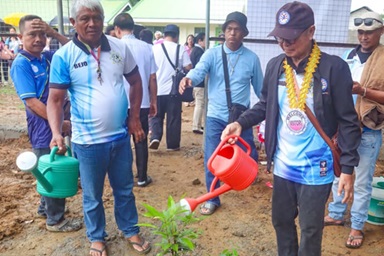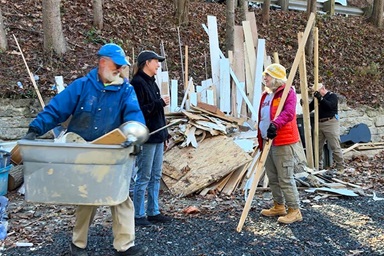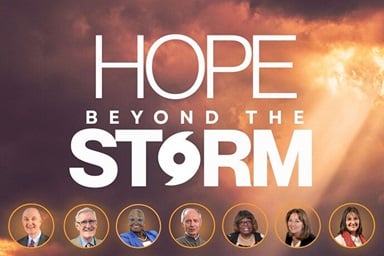Key points:
- The winds of Hurricane Katrina in 2005 toppled Rayne Memorial United Methodist Church’s 60-foot steeple and sent it crashing through the roof.
- On the first Sunday the church opened for worship in the fellowship hall, the congregation set out about 12 chairs but so many people came they kept needing more.
- The church became a hub for housing and deploying volunteer teams that came to muck and gut the houses around New Orleans.
Rayne Memorial United Methodist Church had been known as the “Church of the Lighted Steeple” since 1875, but the winds of Hurricane Katrina in 2005 toppled the 60-foot steeple and sent it crashing through the roof.
The Rev. Callie Winn Crawford, then pastor at the church, told her congregation, “Now you must be known as the ‘Church of the Lighted People.’”
It took three years, but the steeple and its light shines bright again. Twenty years after the storm, the congregation continues to be the church of the lighted people, Crawford said. She is now semi-retired and preaching at Algiers United Methodist Church in New Orleans.
Crawford had evacuated to Baton Rouge, Louisiana, but returned as soon as they started opening New Orleans for “look and leave” opportunities for residents.
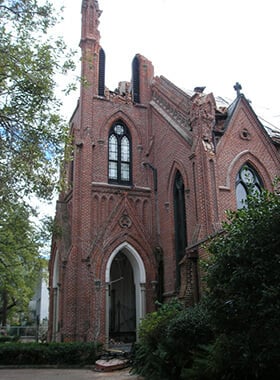
“You could come in for a look at dawn, but you had to leave before dusk,” she said. “When I came in, there were no street signs and it looked like the moon. It was just ash and debris everywhere.”
She said that National Guard vehicles were the only ones on the streets and every now and then, a Humvee would roll down St. Charles Avenue in front of the church.
Crawford said a member of the National Guard told her they called New Orleans “Baghdad on the Bayou.”
When the city opened in the church’s ZIP Code, Crawford expected people to come flooding back, but she was the only one waiting at dawn to enter the city.
“I was alone in the parsonage for a long time.”
On the first Sunday Rayne Memorial opened for worship in the fellowship hall, Crawford set out about 12 chairs. They arranged a makeshift worship area and she prepared a simple service.
“It was a ghost town,” she said, but the service was packed. They had to keep getting more chairs.
“I don’t know how the word got out, but people drove by and said they saw the sign on the front that said ‘open.’ There weren’t very many buildings that had ‘open’ on them. It was such a great thing — every time you saw a new ‘open’ sign you had to rejoice.”
Crawford came back to see the city had put a “condemned” sign on the front door of the church. She said she had printed an “open” sign while she was in Baton Rouge, so “I put it right next to the condemned sign with an arrow pointing to a safer entrance.”
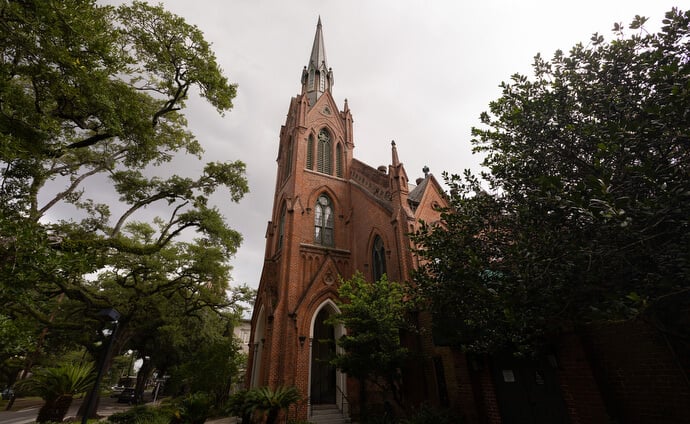
Rayne Memorial lost about one-third of its leadership and one-third of its membership after the hurricane. The United Methodist Children’s Home, which used to bring their children every Sunday to worship, moved to Ruston, Louisiana, and later closed. Other churches closed or were repurposed.
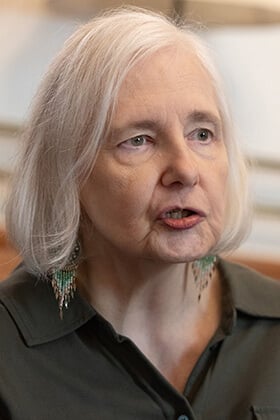
Ellen Blue, author of “In Case of Katrina: Reinventing the Church in Post-Katrina New Orleans,” said, “We couldn’t find some of the pastors for a long time.”
The Louisiana Conference made the commitment not to send any pastor back to New Orleans that didn’t want to go, Blue said.
Crawford said there was a time early on when people did not believe New Orleans would come back. She remembers the first funeral she preached after Katrina.
“I got this call asking if I could do a funeral in the French Quarter. A man died in Lakeview (a part of New Orleans that experienced high floods). He and his wife had evacuated to their attic as the water rose. The husband remembered he had left their keys and IDs downstairs. He told his wife he would be right back. He never came back.”
His funeral was held in a little café, she said.
“After that, his brother came every year to our Maundy Thursday service. He was always there for communion. There are just a lot of heartbreaking stories.”
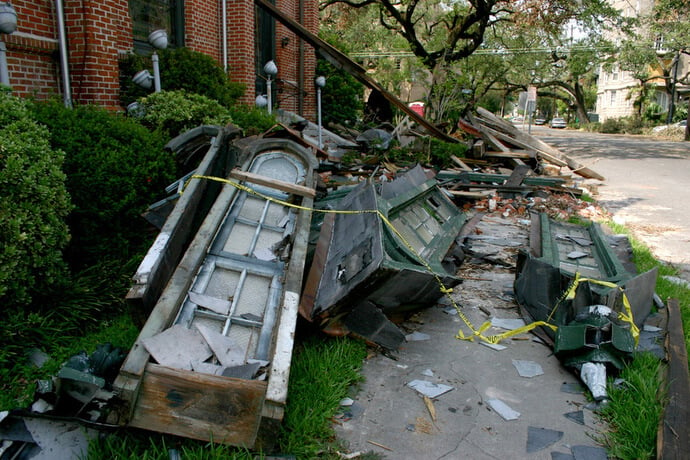
New Orleans doctor answers call to serve after hurricane
Dr. Susan Berry was leaving New Orleans with her family to escape Hurricane Katrina, but she felt called to stay and help during the public health crisis that followed.
Shawn Darnell, Rayne Memorial’s executive director of facilities, worked with the United Methodist Committee on Relief’s New Orleans storm station in 2005. She helped schedule, house and deploy the teams that came to muck and gut the houses around New Orleans.
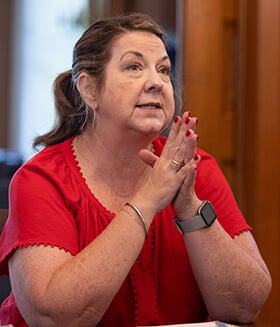
“I’ve never realized the impact that Katrina had in a good way with the people that it drew,” Darnell said. “It was the best of times and the worst of times.”
Crawford remembers the early days of recovery as “very poignant, very hard, but just powerful.”
She said the hallway outside the fellowship hall was stacked from floor to ceiling with flood buckets and baby clothes, diapers and the kinds of things needed in a mission site.
“Some churches pay big bucks to get a consultant to tell them what their mission is. It was just screaming at us every day,” she said.
The church put in three showers and brought in 40 air mattresses.
“We hosted volunteer teams for almost three years until the bishop said: ‘Stop!’’’
At first, Crawford said she was obsessed with trying to find all the congregation members who left during the storm.
“We put up a big map in the hallway and would put push pins in the places where Rayne members had evacuated. It wasn’t long before we took those down and put push pins for all the volunteers and what cities they came from,” she said.
“That bit of transition will always be a sign of hope for me.”
Darnell said she would not have wanted to be in any other part of the recovery work because of the volunteers.
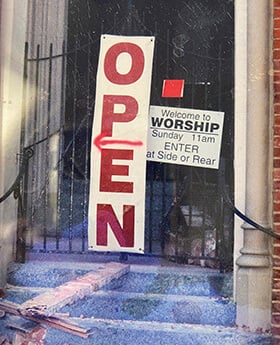
“The new groups coming in every week refreshed our souls. I think The United Methodist Church had an advantage because UMCOR existed before Katrina. While some were trying to work this out, we already had a good system,” Darnell said.
“I don’t think New Orleans would have ever recovered if not for those volunteers,” she added. “St. Marks in Lincoln, Nebraska, sent a team every year for 16 consecutive years.”
In terms of case management, in terms of volunteers, and in terms of staying for years, “I don’t think anyone rivaled The United Methodist Church,” Blue said.
Crawford said a friend from California came to visit and commented on how many volunteer church teams were working in New Orleans.
“She asked me, ‘Is New Orleans going to be rebuilt by the church?’”
Crawford added that along with many volunteers were the countless undocumented immigrants who rebuilt the city.
“At one time there was a serious conversation about erecting a statue in their honor,” she said.
Faith-based free clinic serves community
Luke’s House, a free clinic in New Orleans started by United Methodists, grew out of a need after Hurricane Katrina closed most avenues to health care.
Gilbert is a freelance writer in Nashville, Tennessee, who covered the aftermath of Hurricane Katrina for UM News in 2005.
News media contact: Julie Dwyer at [email protected]. To read more United Methodist news, subscribe to the free UM News Digests.
